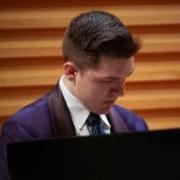All Activity
- Today
-
Henry Ng Tsz Kiu started following Arrangement for Like JENNIE
-
Dear all, I am seeing other composers to arrange pop music recently, so I give it a try. (So bored this weekend for some reason) It is Like JENNIE by Jennie (Blackpink). It is my first time transcribing a pop song. There are no official scores available online for my reference, so I have to do it by ears. (Tried transcribe it with Youtube-to-mp3/midi converter but that was a mess too) If I have to say, the most difficult part is to mimic the half-singing-half-speaking voice of Jennie. Complicated rhythm and very chromatic (and nearly atonal) "melodies" that I have to do it in 0.25x. Took me almost 3 hours to complete the transcription for the 3-minute piece and did some orchestration for the another 1-2 hours. Hope you enjoy it and please feel free to comment on it. Thank you! HoYin Disclaimer: I do NOT own the music. All rights reserved by Jennie et al. Original MV: My arrangement:
-
Firstly, Thank you. (Why can't I add any reactions today? It was my first one today!) Anyways, I was able to play the opening for the pianos.You just have to plainly memorize the notes for piano 1, and play chromatic notes for piano 2. At bar 128, it meant that the sharped note should be played with a slightly more stronger accent, because written with a sharp. You see, the bass clef seems darker to me (except if the treble clef behaves like feux follets or the opening of the piece). I really like to use tremolos. And again, thank you very much for the positive feedback and comments. I appreciate it.
-
@MK_Piano Thank you for your kind reply. I hope my music is still pleasant to "post-tonal" ears. I treat it as a compliment when audience tell me they are willing to revisit - that means there are some places of work that is worth memorizing. While in the post-tonal context, while there are lots of idea I want to express in my work, I agree that there should only be "necessary" details in the writing - audience should be able to enjoy the work with their ears - instead of intelligently enjoying the tuplets or excessive dynamic markings by compulsively referring to the score.🫠 Gosh, I apologize for the double stops. I hope all violinists and pianist will forgive me for the effect.😆 While this work will be a part of my larger set of project "Festive", I do want to make it distinctive from other few works. So yes, I am writing this Halloween music with a storyline and realistically refering to the tradition - glad to hear from you I might have succeeded to convey the idea. Thank you!
-
MK_Piano started following A hollow theme for Halloween (Fall 2025 competition)
-

A hollow theme for Halloween (Fall 2025 competition)
MK_Piano replied to therealAJGS's topic in Electronic
It depends on your goal. Your intuition allowed you to make a piece of music that a normal person would say sounds fine/ cool. For a more refined level, you can take that intuition and apply things like chords or melody structure. All of which will allow you to replicate your work more consistently versus "doing so because music theory is essential for writing good music". If you want a free, collegiate-level, link to start learning music theory, consider checking out Music Theory for the 2st Century Classroom. This site is the one I used as a Freshman and Sophomore. It's pages of music fundamentals to complex theory; it is also paired with exercises and worksheets for when you want to practice these skills. -
I enjoy this piece! The choice of the woodwinds is good - balanced timbre - especially with oboe adding some sense of mystery to the work. The melody is pleasant to listen to, and the development is natural and colourful. But in terms of the competition, I think it might not be the best fit in the "Halloween" theme (perhaps too joyful? 😅) However, I think section N and O lost some "energy" there - I know you may want to depict the gradual diffusion (dying out) of the smoke - I believe there are potential to be more harmonic before the recapitulation. Regarding the playability, I think it is completely fine, in terms of the clear indication and suitable difficulty to the players. Irregular time signature is a feature here. I think it is a light-hearted work that is worth a concert performance! Good work!
-

YCF Composition Competition - Halloween 2025 (Submission)
MK_Piano replied to UncleRed99's topic in Chamber Music
Hey Red! I've been making it goal to comment at least once on the halloween submissions and here I am! In our separate conversations, we have already spoken a lot on the piece, from how you created it, to how a new key/ scale can affect it, and how engraving can make or break a musicians understanding of the work. For those who have known your previous works over the last few months -> year, there is a clear sophistication in this work. I can see the clear sense of structure and harmonic language you presenting and I cannot state that enough. In the halloween sense, I am a big fan of the little dance after the A-section. It is very fun to listen to. Good work my friend! Let this only be a stepping stone to your greater works 🙂 -
What a wonderful piece of music. Musically speaking, I greatly appreciate your abilty to develop the motif over the course of the work. It was entrancing and even went it felt dissonant, I was listening with intent. I do have specific critiques on the engraving/ format of the score: I think it would be a better decision to increase the margins of the entire score. All printers have a margin where they will not put any ink on the outside of the paper (This is called the bleeds). If you were to view your PDF and hit the print button, it will automatically update the margins. (I have attached two screenshots to show this). I also think you can space out the measures more in certain spots (mm.31-58) even when instruments are playing. A pianist would read a part with all 3 instruments on there to help with coordination and having it spaced out may be a nice convenience. Lastly, I recommend adding system dividers to separate the score and to add rehearsal marks so one day, a trio can actually rehearse and use specific places in the score to practice. Lovely video to accompany this as well! 🙂
-
In the modern landscape, this, to me, was refreshing to listen to. I have experienced listening to bad post-tonal works where my peer thought more noise and crazy writing benefited the music or hall being played. I appreciate the landscape you painted and would not mind listening to this again in the future. Of course, on an objective level, this piece is difficult. I think it would be effective when played live, however, I would be the one to pass off learning it and give it to the next musician due to the ensemble difficulty lol. When applying it to Halloween, I think you have succeeded. Maybe not in the terms of the 'trick or treat' or lighthearted celebration that happens each year, but in terms of capturing the eerie and scary images a haunted house or creepy film shows. Good work!
-
@Justin Gruber I appreciate this submission a lot. Some of comments or ratings seem to come from a place of tonality and western structure versus the post-tonal lens this casts. For the style, I think the execution works well. This said, this will take time for performers to nail due to the syncopation playing tricks on their ears, however, I think it is a better condition for it to be challenging on an ensemble level versus a soloistic level. (I have a feeling you already know this to be true lol) For my personal style, I would space the measures out more and keep it to 4-6 measures versus a long stave of 8 measures. Even though you can fit 8 measures in one system, it grows to be a little "cluttery" at times (Measures 56-80). My final critique is when you apply this piece in the sense of "Halloween". I am not 100% convinced this conveys Halloween. It seems to cast the fall season in my opinion. I did not feel a "spook" or sense of "creeping" when listening. Other than these comments, I found your work to be enjoyable! Love to see when people employ some good front matter and proper copyright information. 🙂
-
@TristanTheTristan As I am still getting accustomed to the site, I have taken it upon myself to get familiar with some of the other forums and type of music people have put on YCF. I have been interested to explore what people have to offer, and from my curiosity, I decided to also start giving feedback on scores submitted by people for this Halloween Competition. This said, to whomever I comment on, I will be treating them like a professional and write based on the expectation that they know, at minimum, intermediate music theory. For now, I will avoid making a table of my rating, however, please find the following to be my review of your submission. As a final note, I like to be straightforward with colleagues, and by no means am I coming from a place of bad faith. I want to push my peers to new heights, and I will be honest with them so they know the truth and can evolve from there. __________ While fitting the criteria of the competition, I do not see this piece as a practical work made for performance. I have noticed multiple errors where a professional concert pianist would have a high level of difficulty playing this work; specifically "Variation 4" where you employ single note tremelos. However, they are not uncommon to use as Liszt, and Debussy used them in their music. Liszt in the Friska from "Hungarian Rhapsody no. 2" and Debussy from the Prelude "...Ce qu'a vu le vent d'ouest". In comparison, your usage of them is more difficult due to the amount of note shifts a pianist will have to do, versus the raw technique. In a similar mindset, I do not believe the first section from measures 1-40 to be realistically playable on the piano. Continuing on, the engraving for the score concerns me heavily. The measures seem to be too small or placed too closely together throughout and in spots, like measure 128, you have two different spellings for the same note (G# and Ab). Musically, is it rather interesting and I did enjoy the theme you created. I love to write in D-minor when given the chance, and I was vibing with the "sinister" nature the key provides in your theme. If you would like to talk more or explore these comments, I would not mind doing so. Thank you for taking the time to read this 🙂
-
a piece for my very beta game: cat. play here: https://flowlab.io/game/edit/2837945
-

A hollow theme for Halloween (Fall 2025 competition)
Kvothe replied to therealAJGS's topic in Electronic
@therealAJGS: you can learn after this. Any one here, can help with theory, form, and etc. 🙂 - Yesterday
-

2025 Halloween Competition - DANCE FROM THE SKELETON BALL (Submission)
Kvothe replied to MK_Piano's topic in Chamber Music
Again, maths. Yes. I will now correct that. -

2025 Halloween Competition - DANCE FROM THE SKELETON BALL (Submission)
MK_Piano replied to MK_Piano's topic in Chamber Music
Thanks for the rate! Just to clarify: Based on this table, wouldn't the average be 9.6875 and not 8.4? -
This piece is my first attempt to convert my MIDI sketches into notation. I am still pretty amateur at both composition and notation, so constructive feedback would be greatly appreciated. This was written for a medium sized orchestra, with particular emphasis on strings, a female soloist, and mallet percussion (glockenspiel, etc). I've been composing as a hobby for a while but this is one of my first attempts at really trying to improve the fine details of a piece and make it playable for real. So what I mainly want to know is how this midi-composed piece does in notation form and what could be made better. I'm especially looking for feedback on the following: Orchestration & Clarity: Are the parts written idiomatically for the players? Is the notation understandable? Balance: How is the balance between the main melodies and the background textures? Overall Sound: How is it overall? Is it effective, how does it sound, what could be improved? I have attached a pdf of the score, an mp3 of the original midi file, and a link to a video of the score plus the Musescore audio. Thank you! Score + Audio
-
Burlap Guy joined the community
-

2025 Halloween Competition - DANCE FROM THE SKELETON BALL (Submission)
Kvothe replied to MK_Piano's topic in Chamber Music
Here's my score: Average score: 9.7(very good) I do not think much to say on this piece. Melodies Themes Motives Harmony Chords Textures Form Development Structure Time Originality Creativity Score Presentation Instrumentation Orchestration Playability Execution of Given Challenge Taste 10 9.5 9.5 10 10 9.5 10 9 -

Fall 2025 Halloween Competition
Kvothe replied to PeterthePapercomPoser's topic in Monthly Competitions
I have am enjoying this competition. 🙂 -

2025 Halloween Competition - DANCE FROM THE SKELETON BALL (Submission)
Kvothe replied to MK_Piano's topic in Chamber Music
Hello @MK_Piano I will score your work later today. Stay tuned! -
@TristanTheTristan Since this a barque dance, a minute , it is AB (binary). So the A section is tonic (C major) and B section is domiant (G). m3 of the A section, is vi and leads I...this is fine. Then in measure m7, it is V-I and we repeat the A section. We don't transition to the minor!
-
MP3 Play / pause Minuet I 0:20 1:20 volume > next menu Minuet I > next PDF Minuet 1 Ok. So you have some nice thematic material. Sometimes, like bars 3 and 7 don't make sense to me that much. Maybe explain that? Bar 2's last beat has a straight-forward transition to a minor. It just feels off. The second section was more favourable to my ears.
-
Melodies Themes Motives Harmony Chords Textures Form Development Structure Time Originality Creativity Score Presentation Instrumentation Orchestration Playability Execution of Given Challenge Taste 7.5 8 6.5 8 8 7 9 7 Review: Form Development Structure Time: 6.5 I score this 6.5 for it was hard to listen to ABA form for 7 minutes. You have to keep in mind that the general listener has short attention span. ABA are usually shorter. But given the time frame that we had to meet...I realize the challenge it was to write ABA. Score Presentation: 8 I score this an 8 for the score looked professional; and if you send this to ensemble they would be probably say yes. Instrumentation Orchestration Playability: 7 There were some interesting spots when the music went into 7 where the division changed every measure. Not to mention that meter of the piece changed throughout You have to count for sure. Originality Creativity: 8 This was truly original concept and your put thought and creativity into. Kudos Melodies Themes Motives: 7.5 In the A section, there was ostinato that held it together. that was interesting, The interplay between flute and oboe grabbed my attention. Harmony Chords Textures: 8 The texture of this piece was not homophonic but polyphonic and borderline polymetric. So there was more independency of the three parts than chorale. Execution: 7.5 It meet reequipment to write a trio and time, but I did not feel it for Halloween. Taste: 7 This is hard to describe. I feel this would be great for concert. Average score: 7.6 Standard
-
[DO NOT REPLICATE - ALL RIGHTS RESERVED] The last calendar year has seen the most growth in my music writing. In June, 2024, I was given the opportunity to work with the Huntsville Youth Orchestra in Alabama, and their resident composer, Robert Bradshaw. I stayed with them for one week preparing my piece "Mountain Storms and Valley Peace" for performance. (You can listen to the world premiere of spotify!) I cannot express the amount of information I received during this experience. It changed me for the better as a composer and as a musician. So much so, it inspired me to write my first suite for Symphonic Orchestra: Chariot to the Moon, Apollo. Over the course of 5 months from August, 2024 - December, 2024, I composed this five movement-long suite detailing the achievements of man in the conquest of space; specifically, the Apollo Program. If you would like to know more information regarding the work, you can read my notes in the "About" section on page three. ___________ This suite takes about 24 minutes to listen to in its entirety. I have decided to share the entire score, with a watermark added, for your enjoyment and to help with following the piece as it plays. I would love to hear your thoughts in the comments! Thanks for taking the time to look and listen to my composition!
-
- 3
-




.thumb.png.1e2763f479362bbb522da50d31ef2e50.png)
